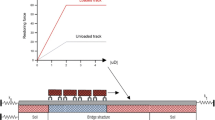Abstract
This paper made a revisit on the contact behavior and application of a beam (rail) on a half-plane/half-space. It is found that when the beam is subjected to a concentrated force, the shear deformation of the beam must always be considered, because the deformation only occurs within a limited length of the beam. The second finding of this paper is that the reactions and the surface settlements of the half-plane/half-space are significantly affected by the load position on the cross-section of the beam (on the top of rail in the concerned areas of application) and must be considered in practice. The Flamant/Boussinesq solutions are used to establish integral equations for the surface settlement of the half-plane/half-space below the beam. The Fourier Transform is applied to the first derivative of these integral equations and to the differential equations of the Timoshenko beam. Solving these two equations and employing the inverse Fourier Transform, the deflection and the reaction can be obtained in a compact format. After dispersing the wheel pressure on top of the rail to the centroid, the deflection and reaction are in agreement with the finite element analysis. Finally, simplified equations for equivalent bearing lengths are proposed. Nonuniform distribution of the reactions along the width of the beam is treated by using an equivalent uniform width. If the shear deformation is ignored, the problem becomes the classic one solved by Biot (J Appl Mech 4:A1–A7, 1937). Compared with Biot solution, the current way of solution is compact, their minor differences are the characteristic length. The current solution is a fourth root while the Biot solution is a cube root.














Similar content being viewed by others
Abbreviations
- FEM:
-
Finite element model
- FE:
-
Finite element
References
Biot MA (1937) Bending of an infinite beam on an elastic foundation. J Appl Mech 4:A1–A7
European Standard: Eurocode 1993-6:2007, Design of steel structures—part 6: crane supporting structures. In: European Standard, editor (2009)
Gorbunov-Posadov IM, Malikova TA, Solomin VI (1984) Calculation of structures on an elastic base. Stroyizdat, Moscow
Wang YH, Tham LG, Cheung YK (2005) Beams and plates on elastic foundations: a review. Prog Struct Mater Eng 7(4):174–182
Selvadurai APS (2015) Li Shi:Biot’s problem for a Biot material. Int J Eng Sci 97:133–147
Selvadurai APS (2007) The analytical method in geomechanics. Appl Mech Rev 60:87–106
Timoshenko SP, Woinowsky-Krieger S (1959) Theory of plate and shells. McGraw-Hill, London
Timoshenko SP, Goodier JN (1970) Theory of elasticity. McGraw-Hill, London
Yi H, Fangshe He (2005) Beams, plates and shells on elastic foundations. China Science Press, Beijing
Wang CL, Huang Y (2005) Analytic solution of rectangular plates loaded with vertical force on an elastic half space. Chin J Geotech Eng 27(12):1402–1407
Aiqin W (2008) Analytic solution of beams loaded vertical force on elastic half space. J Chang’An Univ Nat Sci Edn 28(5):73–76
Cheung YK, Zienkiewicz OC (1965) Plates and tanks on elastic foundation: an application of the finite element method. Int J Solids Struct 1:451–461
Aleynikov SM (2011) Spatial contact problems in geotechnics. Boundary element method. Springer, Berlin
Runbo B, Pingzhou C, Maosen C (2009) Investigation on contact behavior between steel-gate track and concrete foundation. Hydro-Sci Eng 1:10–16
Sneddon NI (1951) Fourier transforms. McGraw–Hill, New York
Ministry of Housing and Urban-Rural Development of the People’s Republic of China: GB50017–2017 Standard of design of steel structures (2017)
Author information
Authors and Affiliations
Contributions
All authors contributed to the study conception and design. We do all the work together. The first draft of the manuscript was written by Genshu Tong and all authors commented on previous versions of the manuscript. All authors read and approved the final manuscript.
Corresponding author
Ethics declarations
Conflict of interests
The authors did not receive support from any organization for the submitted work. The authors have no relevant financial or non-financial interests to disclose.
Additional information
Publisher's Note
Springer Nature remains neutral with regard to jurisdictional claims in published maps and institutional affiliations.
Appendix: Comparisons between the present paper and the Biot solution
Appendix: Comparisons between the present paper and the Biot solution
-
1.
In [1], the load of (48) (\(n(y) = 1.0\)) was expanded in the full range of \(- \infty \le y \le \infty\), so the Biot solution required the following integration (keeping Biot’s notation)
$$\int\limits_{0}^{\infty } {\frac{{\sin \left( {y/b + 1} \right)\alpha }}{{\alpha \sqrt {\alpha^{2} + \beta^{2} } }}} d\alpha \;{\text{and}}\;\int\limits_{0}^{\infty } {\frac{{\sin \left( {y/b - 1} \right)\alpha }}{{\alpha \sqrt {\alpha^{2} + \beta^{2} } }}} d\alpha$$(60)Such integrals do not appear in the paper.
-
2.
The characteristic length defined by [1] was
$$L^{\prime } = \left[ {C(1 - \nu^{2} )\frac{{E_{b} I_{b} }}{Eb}} \right]^{1/3}$$(61)while in the paper the characteristic length is given by (38), which is a fourth root and has no relation with the beam half-width \(b\).
-
3.
If shear deformation is neglected, \(\alpha_{s} = 0\), Eqs. (42) and (43) become
$$w(x) = \frac{{2(1 - \nu^{2} )Pc}}{{\pi^{2} EL}} \cdot \int\limits_{0}^{\infty } {\frac{\Omega (\beta )\cos (\beta c\xi )}{{1 + c^{4} \beta^{4} \Omega (\beta )}}d\beta }$$(62)$$M(x) = \frac{PL}{\pi }c^{3} \int_{0}^{ + \infty } {\frac{{\beta^{2} \Omega (\beta )\cos (\beta c\xi )}}{{1 + c^{4} \beta^{4} \Omega (\beta )}}d\beta }$$(63)
In [1]
(62) and (63) are found to be the same as (64) and (65) respectively, if the following equation is valid:
The development of the function \(\Psi (\beta )\) in [1] was as follows:
When \(\zeta > 0.1\) and \(\beta \ge 0.1\), values of the functions \(\varphi (\zeta )\) and \(\Psi (\beta )\) are tabulated in Table
5.
Comparison of \(\frac{\pi }{2\beta \Psi (\beta )}\) in [1] with \(\Omega (\beta )\) of this paper is illustrated in Fig.
15, some differences are obvious. It seems that [1] has a misprint in (67). If it has the following form, the agreement between both is achieved although (33) has a better accuracy:
Rights and permissions
About this article
Cite this article
Tong, G., Xuan, Z. Contact behavior between rail and elastic foundation. Meccanica 57, 1477–1489 (2022). https://doi.org/10.1007/s11012-022-01491-y
Received:
Accepted:
Published:
Issue Date:
DOI: https://doi.org/10.1007/s11012-022-01491-y





